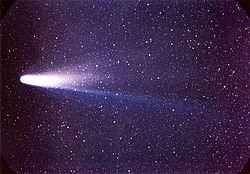Halley's Comet
 | |
| Discovery | |
|---|---|
| Discovered by | prehistoric (observation); Edmond Halley (recognition of periodicity) |
| Epoch 2449400.5 (17 February 1994) | |
| Aphelion | 35.1 AU (9 December 2023)[2] |
| Perihelion | 0.586 AU last perihelion: 9 February 1986 next perihelion: 28 July 2061[2] |
| Semi-major axis | 17.8 AU |
| Eccentricity | 0.967 |
| Orbital period | 75.3 a[1] |
| Inclination | 162.3° |
| Physical characteristics | |
| Dimensions | 15×8 km,[3] 11 km (mean)[1] |
| Mass | 2.2 × 1014 kg[4] |
| Mean density | 0.6[5] (estimates range from 0.2 to 1.5 g/cm3[6]) |
| Sidereal rotation period | 2.2 d (52.8 h) (?)[7] |
| Albedo | 0.04[8] |
| Apparent magnitude | 28.2 (in 2003)[9] |
Halley's returns to the inner solar system have been observed and recorded by astronomers since at least 240 BC, and perhaps as early as 466 BC.[12] Clear records of the comet's appearances were made by Chinese, Babylonian, and medieval European chroniclers, but were not recognized as reappearances of the same object at the time. The comet's periodicity was first determined in 1705 by English astronomer Edmond Halley, after whom it is now named. Halley's Comet last appeared in the inner Solar System in 1986 and will next appear in mid-2061.[13]
During its 1986 apparition, Halley became the first comet to be observed in detail by spacecraft, providing the first observational data on the structure of a comet nucleus and the mechanism of coma and tail formation.[14][15] These observations supported a number of longstanding hypotheses about comet construction, particularly Fred Whipple's "dirty snowball" model, which correctly surmised that Halley would be composed of a mixture of volatile ices — such as water, carbon dioxide and ammonia — and dust. However, the missions also provided data which substantially reformed and reconfigured these ideas; for instance it is now understood that Halley's surface is largely composed of dusty, non-volatile materials, and that only a small portion of it is icy.
Contents[show] |
[edit] Pronunciation
Halley is generally pronounced /ˈhæli/, rhyming with valley, or /ˈheɪli/ rhyming with daily,[16] but Edmond Halley himself probably pronounced his name /ˈhɔːli/ Hawley, as in the word "hall".[17][edit] Computation of orbit
Halley's Comet was the first comet to be recognized as periodic. Until the Renaissance, the philosophical consensus on the nature of comets, promoted by Aristotle, was that they were disturbances in the Earth's atmosphere. This idea was disproved in 1577 by Tycho Brahe, who used parallax measurements to show that comets must lie above the Moon. However, many were still unconvinced that comets actually orbited the Sun, and assumed they must instead follow straight paths through the Solar System.[18]In 1687, Sir Isaac Newton published his Principia, in which he outlined his laws of gravity and motion. However, his work on comets was decidedly incomplete. Although he had suspected that two comets that had appeared in succession in 1680 and 1681 were in fact the same comet before and after passing behind the Sun (he was later found to be correct; see Newton's Comet),[19] he was unable to completely reconcile comets into his model. Ultimately, it was Newton's friend, editor and publisher, Edmond Halley who, in his 1705 Synopsis of the Astronomy of Comets, used Newton's new laws to calculate the gravitational effects of Jupiter and Saturn on cometary orbits.[20] This calculation enabled him, after examining historical records, to determine that the orbital elements of a second comet which had appeared in 1682, were nearly the same as those of two comets which had appeared in 1531 (observed by Petrus Apianus) and 1607 (observed by Johannes Kepler).[20] Halley thus concluded that all three comets were in fact the same object returning every 76 years, a period that has since been amended to every 75–76 years. After a rough estimate of the perturbations the comet would sustain from the gravitational attraction of the planets, he predicted its return for 1758.[21]
Halley's prediction of the comet's return proved to be correct, although it was not seen until 25 December 1758, by Johann Georg Palitzsch, a German farmer and amateur astronomer. It did not pass through its perihelion until 13 March 1759, the attraction of Jupiter and Saturn having caused a retardation of 618 days.[22] This effect was computed (with a one-month error to 13 April)[23] by a team of three French mathematicians, Alexis Clairault, Joseph Lalande, and Nicole-Reine Lepaute,[24] previous to its return. Halley did not live to see the comet again as he died in 1742.[25] The confirmation of the comet's return was the first time anything other than planets had been shown to orbit the Sun. It was also one of the earliest successful tests of Newtonian physics, and a clear demonstration of its explanatory power.[26] The comet was first named in Halley's honour by French astronomer Nicolas Louis de Lacaille in 1759.[26]
The possibility has been raised that 1st-century Jewish astronomers had already recognized Halley's Comet as periodic.[27] This theory notes a passage in the Talmud[28] which refers to "a star which appears once in seventy years that makes the captains of the ships err".[29]
